MAIN MENU
Diamond Doves
Site Map
Diamond doves
Acquiring Diamond Doves
Caring for Diamonds
Living With Diamonds
Raising Diamonds
Growth of a Diamond Baby
One Year's Reproduction Data
Tribute to China
Other Dove Species
Other Geopelia SpeciesRingneck Doves
Eurasian Collared Doves
Cape Doves
Mourning Doves
Mourning Dove Baby Growth
Rock Pigeons
North American Doves
Dove Genera of the World
All Doves
Caring for Injured or Sick DovesTaming Doves
Other
Books of Interest
Some Bird stories
About Me
Links
Informational Sites
American Dove AssociationCommercial Sites
Jeff Dowining - Diamond DovesGarrie Landry - Diamond Doves
Wade Oliver - The Dove Page
Doveland Press - Diamond Doves
Eurasian Collared Dove
Streptopelia decaocto
Eurasian Collared Doves in Winter Weather
January 2007
Photo by Linda Jacobson of Leander, Texas
Several people have written in wondering about the identification of this dove. Most people believe they are looking at the domesticated ringneck but are surprised because these birds are being found in areas that have cold winter climates. The domesticated ringneck does not do well in areas that have temperatures below freezing. On top of that it is very difficult to tell the two birds apart unless you see them side by side. Then it can be seen that the Eurasian Collared Dove is definitely much larger than the ringneck. In most cases the Eurasian dove can be identified through its usual call and occasional scream. Also the black spike at the edges of the bottom side of the tail feathers is unique to this species. This spike can be seen in the above photograph.

Introduction
This bird is remarkable for its expansion of its original range in India and China across to the European continent. Although it originally came from climates with moderately warm temperature, it now lives in areas of extreme cold in Norway, Sweden, and Finland. Apparently it has also migrated to Iceland and the Faero Islands. These birds were imported to the Bahamas in the 1970's. However about 70 birds escaped and soon populated the entire island chain. In the late1980's the dove somehow managed to arrive in Florida and quickly developed colonies along the eastern and western coasts of this state. From there the bird spread along the gulf coast and by the mid 1990s it could be found all the southern states. Since that time it started pushing northward and can now be found in most states except those in the northeast.GREAT BACKYARD BIRD COUNT DATA = AUDUBON SOCIETY
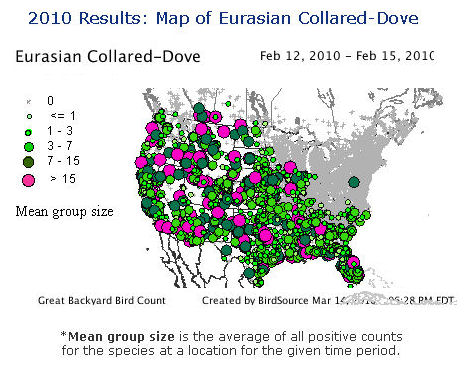
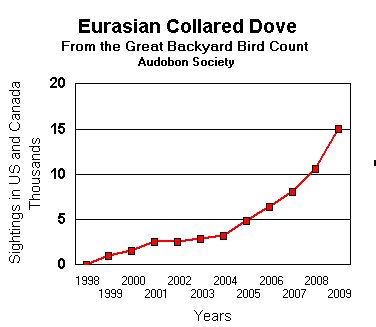
Description
The Eurasian collared dove is slightly larger than the common ringneck or Barbary dove. Their upper bodies have a tan color and the lower body is also tan but with a slightly grayer cast. There is a black ring bordered with a narrow white strip on the back of its neck. The under tail feather have a black base and as mentioned above this base extends into two thin spikes on each edge of the tail.
Eurasian Collared Dove
Photo by Linda Jacobson of Leander, Texas
It should be noted that these doves are known to mate with the domesticated ringneck dove and that the resulting hybrids can be a challenge for those trying to identify them. For example I have a dove that produces the normal Eurasian collared dove calls including the unusual scream but has the body size and appearance of a white albino ringneck.
Distribution
This bird is found in Japan, Korea, China, India, Afghanistan, Iran, Iraq, and across the Middle East to Egypt and into the European continent ranging from Spain in the south, north to the coastlines of the Scandinavian countries, Iceland, and east into Russia. In North America it can be found in the Bahamas and in all the southern and western states of the United States. So far no significant numbers have been reported in the north east
Voice
The advertising call, often heard throughout
its range, is a croo-COOOOO--ku. This call is often repeated two to
ten times or more. This dove also occasionally utters a scream that
is quite startling and unexpected. It seems to be the bird's excitement
coo and is often made after landing from flight. The ringneck dove does not use
this coo but rather makes the laughing coo that they are well known for.
In their original habitat, the Eurasian collared
doves are usually found in dry, open areas with scrub vegetation and scattered
Acacia trees. It was be found from sea level to altitudes of 9000 feet or
more. While resident in most parts of its range, it does migrate from
higher altitudes to lower ones during the winter season. Like many
other doves they can be seen in villages and towns in gardens and parks, and also in cultivated areas.
They do tend to avoid moist forested areas where their light color would stand
out, thus making them more susceptible to hawks and other predators.
Habitat
Feeding
Feeds on the ground, walking rapidly. Eats a wide variety grains and grass seeds. It also eats fruits and berries. When living in suburban areas feeds on bread and other scraps. Usually feeds in open spaces among thorn scrub in the wild, and on roadsides, paths, and in gardens in suburban areas.
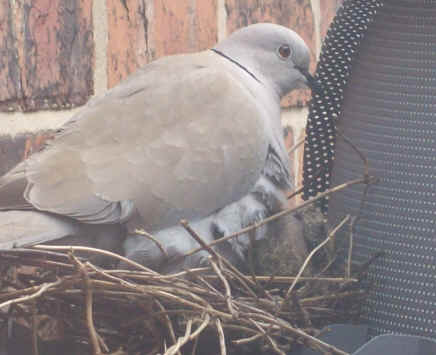
Eurasian collared dove on nest
Photo by Julie Cartwright, Cheshire, UK
Nesting
Eurasian collared doves build the usual type of dove nest in shrubs, on trees, or on building ledges. The female usually lays two cream colored eggs. Incubation last between 14 and 18 days. Babies are reported to fledge between 15 and 19 days.
In this series of photos taken by Julie Cartwright of Cheshire, UK, a storm destroyed the nest leaving the babies on the ground. The nest day Ms. Cartwright found the babies, reconstructed the nest in a large basket, and placed the babies in the new nest. Shortly the parents arrived and continued to geed the babies. The last photo of this group shows the babies almost ready to fledge.
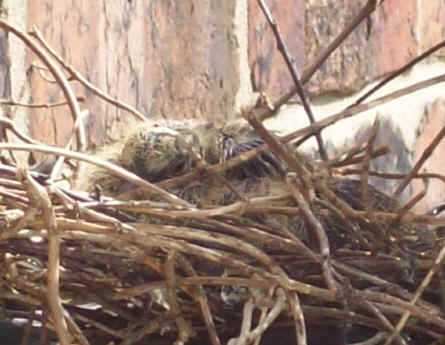
Eurasian collared dove babies in nest
Photo by Julie Cartwright, Cheshire, UK

Older babies in nest
Photo by Julie Cartwright, Cheshire, UK
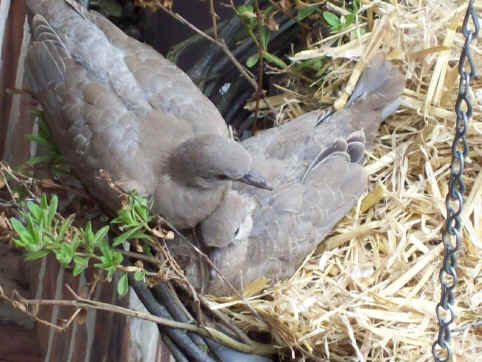
Babies About Ready to Fledge
Photo by Julie Cartwright, Cheshire, UK
Hybrids
Apparently there are a number of breeders that have obtained Eurasian collared doves and have cross bred them with the domesticated ringneck dove. Some breeders have cross bred them with white ringneck doves to obtain more white doves "suitable" wedding and funeral releases. As mentioned in the previous section on ringneck doves this practice is not recommended because these doves can not find their way back to their owner's loft because they do not have the capabilities of a more expensive homing pigeon. Such doves are just left to survive on their own which is difficult because of their white color and the fact that their parents did not teach them how to survive in the wild.
As mentioned in the previous section, a white dove was found after a release in Macon, Georgia and turned over to a wildlife rehabilitator who in turn gave the dove to me. The dove lived with us for a year before I realized it was not a normal ringneck dove. As it tuned out it had the call and scream of an Eurasian collard dove and although the dove was mostly white, it had the faint spike markings on the underside of the outer tail feathers.
Dr. Miller persuaded me to give the bird to an American Dove Association breeder to see if they could determine if the bird was a ringneck x Eurasian collared dove hybrid or if it was some kind of mutant. So far I have not heard about the outcome of these trials.
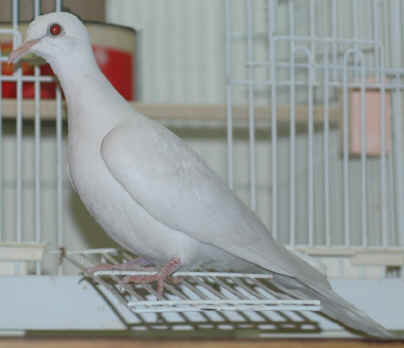
Sahara
Our White Eurasian Collared Dove that we Thought Was a Ringneck
References
(1) Gibbs, David; Barnes, Eustace; Cox, John "Eurasian Collared Dove, Streptopelia decaocto", Pigeons and Doves, A Guide to Pigeons and Doves of the World, London: Yale University Press 2001, pp. 258-260.
(2) Goodwin, Derek, "Collared Dove, Streptopelia decaocto", Pigeons and Doves of the World,
London: Trustees of the British Museum (Natural History), 1967, pp.
116-117.
Helen White
P. O. Box 367,
Tallahassee, FL 32302-0367
Last revised on: January 25, 2007